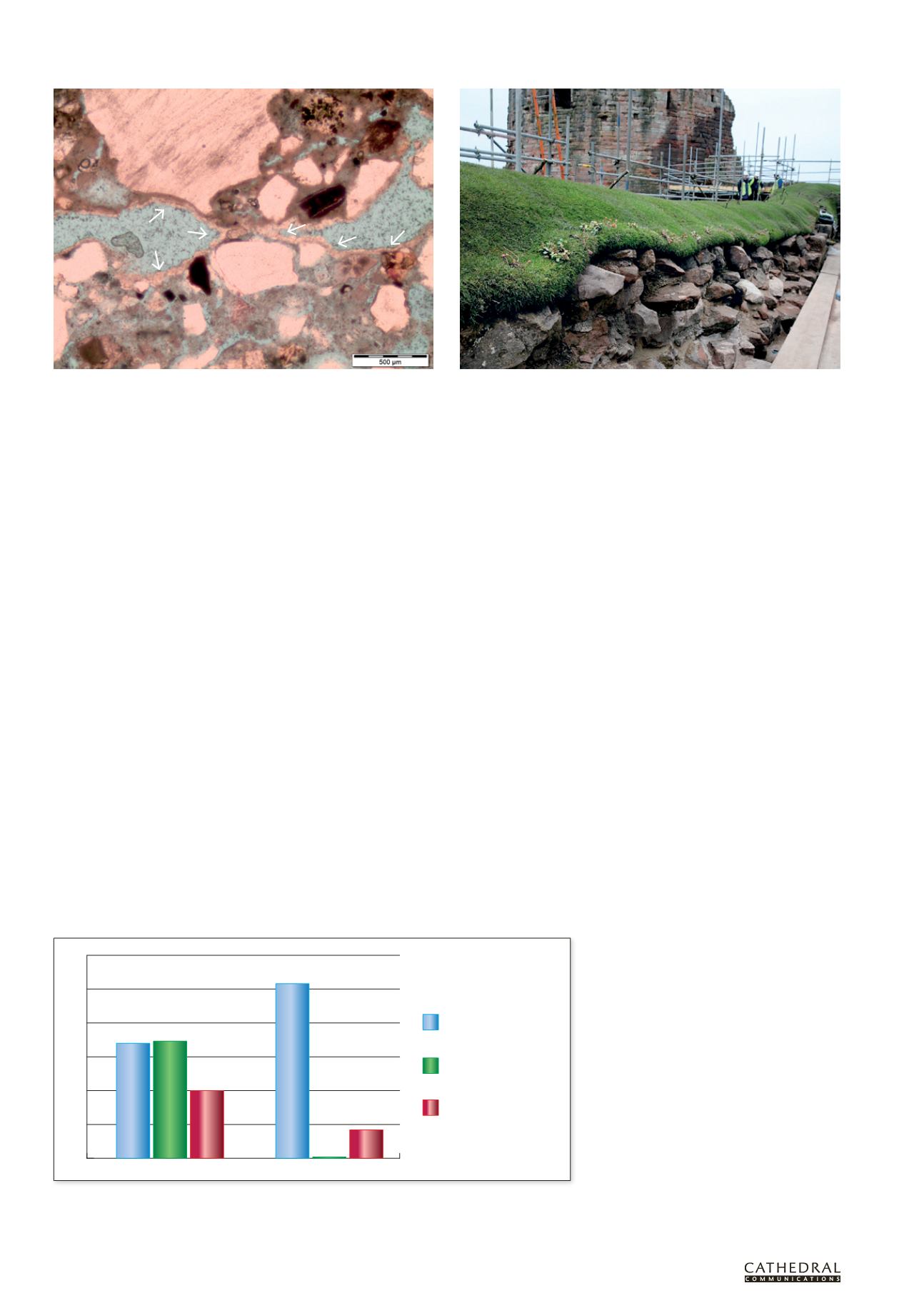

1 3 8
T H E B U I L D I N G C O N S E R VAT I O N D I R E C T O R Y 2 0 1 6
T W E N T Y T H I R D E D I T I O N
SERV I CES & TREATMENT :
PROTEC T I ON & REMED I AL TREATMENT
4.1
limes from different sources. Free lime
content is usually stated in the manufacturers’
technical data.
Pozzolans can also be used to reduce
the free lime available but as they also
affect the microstructure of the mortar,
gauging a non-hydraulic lime with a
pozzolan is likely to result in a mortar
with lower permeability than one based
on the equivalent hydraulic lime.
Providing new works with adequate
protection against moisture ingress reduces
the likelihood of uncarbonated material
leaching while the mortar carbonates. The use
of protective materials need not be restricted
to waterproof membranes and covers; the
use of soft-capping (illustrated above) has
been successful in dealing with high levels of
moisture in exposed conditions, and reduces
the timeframes (and therefore costs) over
which scaffolding is required.
ADDITIVES: IMPACT ON MORTAR
PROPERTIES
Traditionally, natural additives were added to
lime mortars during mixing to alter specific
aspects of mortar performance. Additives
include tallow or linseed oil to enhance
water resistance, and urine to increase
workability. In some of today’s construction
and conservation work, chemically equivalent
additives are still used.
Using additives in mortars can be
beneficial. For example, air entrainers
result in higher porosity and breathability
so they could provide a greater level of
protection from frost. However, due to the
interrelationships between strength, porosity,
permeability, breathability and other factors,
additives rarely impact one property without
also affecting another, so the intended positive
effect might be offset by negative changes.
In the case of air-entraining agents, water
absorption (by capillarity) of the material
is significantly reduced (see graph below).
This means that the material has a lower
permeability and could lead to problems
associated with moisture distribution where
mortars are used on large scales. Such mortars
could shed water rather than absorbing it,
which might lead to increased stresses on
masonry lower down the façade as a result of
the increased run off.
Furthermore, mortars with additives
tend to be more sensitive to workmanship
considerations. Over-mixing and addition
of excess water is likely to have more of an
impact on mortars containing additives
compared with those simply consisting of
lime and aggregate.
The use of additives in mortars for
conservation work should be limited to
cases where their impact is thoroughly
understood. Any potential negative impacts
should be highlighted and judged against
the anticipated benefits. Where possible,
alternative beneficial methods or materials,
such as hot mixing and extra protection,
should be considered first.
Further Information
G Allen et al,
Hydraulic Lime Mortar for
Stone, Brick and Block Masonry
, Donhead,
Shaftesbury, 2003
AM Forster, ‘Hot-Lime Mortars: A Current
Perspective’,
Journal of Architectural
Conservation
, 10 (3), 2004
AM Forster and K Carter, ‘A Framework for
Specifying Natural Hydraulic Lime Mortars
for Masonry Construction’,
Structural
Survey
, 29 (5), 2011
P Gibbons,
Technical Advice Note 1:
Preparation and Use of Lime Mortar
,
Historic Scotland, Edinburgh, 2003
R Kent, ‘The Conservation of Ruins’,
The
Building Conservation Directory
, Cathedral
Communications, 2003
A Leslie, and J Hughes, Binder Microstructure
in Lime Mortars: Implications for the
Interpretation of Analysis Results,
Quarterly
Journal of Engineering Geology and
Hydrology
, 35, 2002
N Razali,
Natural Hydraulic Lime Mortars for
Use in High Temperature, High Humidity
Climatic Conditions: Effect of Calcitic
Fillers
(Unpublished Thesis), Heriot-Watt
University, 2014
J Snow and C Torney,
Lime Mortars in
Traditional Buildings
, Historic Scotland Short
Guide 6, Historic Scotland, Edinburgh, 2014
Acknowledgements
The author wishes to thank the Scottish Lime
Centre Trust for providing access to the thin
sections imaged in Figures 1 and 3, and to
Heriot-Watt University for providing access to
test equipment.
CLARE TORNEY
PhD is a conservation scientist
at Historic Environment Scotland (HES). She
has research interests in building repairs and
compatibility of materials, particularly natural
stone and lime mortars. Her scientific research
helps to provide the foundations of HES
guidance. Email
clare.torney@gov.scotPetrographic thin section of a lime mortar: free lime re-precipitated within a
mortar (indicated by arrows) can block pores reducing permeability
0.0
0.5
1.0
1.5
2.0
2.5
3.0
Breathabilty: vapour
permeability (kg.m .s.Pa)
Water Absorption: sorptivity
(mm/min -½)
Compressive strength (Mpa)
KEY
Mortar with no air entrainer
Mortar with air entrainer
Differences in breathability, water absorption and compressive strength between mortars with and without
air entrainers (tested at 28 days)
Soft capping can be used to help deal with high levels of moisture in exposed
areas. (Photo: Historic Environment Scotland)
Binder
Binder
Pore
Pore
Aggregate
Aggregate
















